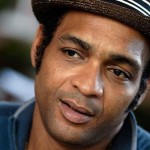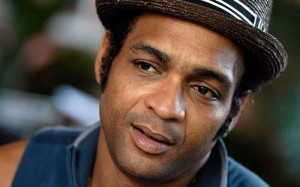He’s a rap-singing, bass-playing, jazz-improvising monument to the versatility and exportability of Cuban music today. Of course, there’s no guarantee he’ll still be in the Plaza Vieja when you come looking for him – he might even vanish before this interview is done – because Descemer Bueno is the kind of monument that doesn’t sit still for long.
He was born in Habana Vieja in 1971 and studied music here, eventually earning credentials to teach. This neighbourhood is also where Estado de Animo (the jazz combo that Descemer formed in the early 1990s with guitarist Elmer Ferrer and trumpeter Roberto Carcasés) used to rehearse. Those rehearsals paid off: Estado de Animo spent much of the ‘90s touring in Spain, Bolivia, Uruguay, Germany and Argentina, and then Descemer went on to tour the United States in 1998 with another jazz ensemble, Columna B. And that’s pretty much how his odyssey began.
Descemer became an artist-in-residence at Stanford University in California and spent a year teaching at the University of South Africa in Capetown. But what he really did was play music and write songs. In 1999 he moved to New York and co-founded Yerba Buena, the now legendary Latin hip-hop outfit. Descemer wrote or co-wrote most of the songs on “President Alien,” Yerba Buena’s breakout debut album.
Yerba Buena’s songs showed up in American movies and Pepsi commercials, but Descemer Bueno moved on. He left Yerba Buena and New York, and started spending more time in Cuba. He started popping up as producer, arranger or composer on what seemed to be every noteworthy album coming off the island. He produced “Haydée” for Haydée Milanés; “La Isla Milagrosa” for William Vivanco; “Breathe” for Yusa; and at the time of this interview he is working on an album with rising star Diana Fuentes. He also produced the score for the film “Havana Blues,” which won him Spain’s Goya award for Best Original Music in 2006.
Meanwhile, his electric bass has never been far from hand. He studied piano and guitar, but the bass had an irresistible appeal for him. “The bass sets the tone for the whole band,” he says. “It’s an everyday instrument, a background instrument – no, an ‘underground’ instrument. The bass walks the streets of the city, you know what I mean? The bass goes everywhere. It’s not especially musical or sentimental – it’s elemental.”
He got his first professional gigs playing bass with Santiago Feliú, one of Cuba’s greatest troubadours. When Feliú put him to work composing songs, Descemer discovered he had a knack for writing lyrics, too. The set of boleros he wrote for Fernando Álvarez just before the singer’s death in 2002 earned Descemer a reputation as a young “bolerista” to be reckoned with.
“Today I’m clearly better known as a composer than as a performer,” Descemer says. “People today seem to recognize my music but they don’t know who I am. But they recognize my music, and that’s what’s really important to me. Seriously – inflated ego and celebrity are things I really try to stay away from.”He thought he had come up with a good formula for avoiding celebrity when he signed to the Universal Latin label to record his first solo album. “I decided I wasn’t going to do reggaeton,” he recalls. “I wasn’t going to do hip-hop. I was going to do fusion.” That album became “Siete Rayo” (2005) and featured contributions from George Pajon of the Black Eyed Peas, who commended Descemer for “rapping in a way that no one is doing in Latin music.’’
Descemer is also known for his writing skills, being a named “bolerista” to be reckoned with after having written a set of boleros for Fernando Alvarez just before the singer’s death in 2002.
Now, as he puts the finishing touches on a second solo album, Descemer is back where he started, hanging out in Plaza Vieja and clearly enjoying it. He has lived in Miami and New York and he recently moved to Los Angeles but – as you can hear in more than a few of his song lyrics – Havana is where his heart is. Havana is also where his mother is, in the same building on Calle Villegas where Descemer grew up.
In 2005 Bueno recorded his first solo album Siete Rayo, a hip-hop fusion album, after signing with Universal Latin. His album featured George Pajon of the Blacked Eyed Peas.
Descemer Bueno worked in a second solo album and produced an album for rising star Diana Fuentes.
In 2010, Bueno produced some songs for Enrique Iglesias’s album Euphoria.
Some of his songs as composer:
“Amor viejo”
“Belleza”
“Breath March”
“Breathe (con Ahmed Barroso)”
“Caimanera”
“Calipso” (con Pável Urquiza)
“Cariño”
“Ciego amor”
“Cimarrón” (con Ahmed Barroso)
“Como una paloma”
“Cumbia reggae”
“De aquí pa’llá”
“De Nueva York a La Habana” (con Pável Urquiza)
“Dime” (con Ahmed Barroso)
“Dime sí en sí”
“Donde van las palabras” (con Vinicius Cantuaria)
“El carro”
“El día tiene unas horas de más” (con Pável Urquiza)
Sé feliz
“When I dream, I dream of these streets,” he says. “I see myself working on more projects here in Cuba now. I come here very often – first off because this is my country and I have my whole family here, but especially because all my musical roots here in Cuba keep pulling me back.” – Descemer Bueno.
Sources: DescemerBueno/InternetPhotos/YouTube/www.thecubanhistory.com
DESCEMER BUENO: Singer, Producer and Composer.
The Cuban History, Arnoldo Varona, Editor
DESCEMER BUENO: CANTAUTOR, PRODUCTOR, MUSICO.
Descemer Bueno. Compositor, contrabajista y percusionista. Uno de los músicos cubanos mas importantes y populares del momento. Exponente de una sonoridad urbana de fuerte vibración contemporánea, un músico llamado a ser historia.
Estudió guitarra en los conservatorios Manuel Saumell y Amadeo Roldán. Es compositor, bajista y cantante. Lideró el grupo Estado de ánimo, luego se unió a Columna B, donde entró en el mundo del jazz, y más tarde, a Grupo Fula, radicado en la ciudad española de Barcelona. Actualmente toca en Yerba Buena, agrupación con la que interpreta fundamentalmente jazz, funk y música afrocubana.
Durante un tiempo, Bueno fue artista en residencia en la Universidad de Stanford en California, y pasó un año enseñando en la Universidad de Sudáfrica en Ciudad del Cabo. En 1999, después de mudarse a Nueva York, Bueno se convirtió en activo en el hip-hop banda Yerba Buena escrito o co-escrito la mayoría de las canciones de su álbum debut “President Alien”. Yerba Buena canciones se pueden escuchar en varias películas americanas y anuncios de Pepsi.
Ha colaborado en trabajos discográficos como “Náuseas de un siglo” y “Futuro inmediato”, de Santiago Feliú; “Trampa del tiempo”, de Pavel y Gema, España, y Jazz timbero, de Bobby Carcassés. En el año 2007 saca al aire junto a Kelvis Ochoa el disco Amor y Música bajo el sello Egrem, al año siguiente, en el 2008 sale bajo el mismo sello el disco Sé feliz, disco de boleros compuestos por él e interpretados por el conocido bolerista Fernando Álvarez.
Recientemente participó junto a Kelvis Ochoa y otros músicos en un concierto humanitario que se realizara en República Dominicana con motivo del terremoto en Haití.
Ha trabajado con Carlos Varela, Boris Larramendi, Santiago Feliz, y los grupos Habana, Estado de Ánimo, con Roberto Carcassés, X Alfonso, Elmer Ferrer y Ruy López-Nussa; después se integra a Columna B, que «tuvo como rasgo distintivo el no encasillarse en un patrón o estilo específico, y en una gira por Nueva York, compartió el escenario con músicos de la talla del saxofonista Steve Coleman: Columna B no sólo interpreta jazz, sino además todo tipo de música instrumental.
Posteriormente formó su grupo Siete Rayo, en el que mezcla ritmos cubanos como el chachachá, la timba y el changüí, «con pinceladas sonoras del Caribe como el reggae, calipso o regguetón, unido a cierta dosis de rap y hasta un poco de cumbia colombiana.
“Hoy soy mejor conocido como compositor que como intérprete,” dice Descemer. “La gente parece hoy a reconocer mi música, pero no saben quién soy. Pero reconocen mi música, y eso es lo que es realmente importante para mí. En serio -. Ego inflado y la fama son cosas que realmente tratar de mantenerse alejado de “Pensó que había llegado con una buena fórmula para evitar la celebridad cuando firmó con el sello Universal Latino para grabar su primer disco en solitario. “Decidí que no iba a hacer reggaetón”, recuerda. “Yo no iba a hacer hip-hop. Yo iba a hacer la fusión. “Ese álbum fue” Siete Rayo “(2005) y las contribuciones de destacados de George Pajon de los Black Eyed Peas, quien elogió Descemer de” rap de una manera que nadie está haciendo en la música latina.”
Ha participado en jam session con Gonzalo Rubalcaba y Wynton Marsalis. In 2005 Bueno recorded his first solo album Siete Rayo, a hip-hop fusion album, after signing with Universal Latin. His album featured George Pajon of the Blacked Eyed Peas.
Descemer Bueno worked in a second solo album and produced an album for rising star Diana Fuentes.
In 2010, Bueno produced some songs for Enrique Iglesias’s album Euphoria.
Recibió en el año 2006 el Premio Goya por la banda sonora de la película Habana Blues del español Benito Zambrano.
Ahora, mientras se pone los toques finales a un segundo álbum en solitario, Descemer está de vuelta donde empezó, pasando el rato en la Plaza Vieja y disfrutando claramente. Ha vivido en Miami y Nueva York y recientemente se mudó a Los Angeles, pero – como se puede escuchar en más de unos pocos de sus letras de canciones – La Habana es donde está su corazón. La Habana es también el lugar donde su madre es, en el mismo edificio, en la calle Villegas Descemer donde creció.
Algunas de sus obras
“Amor viejo”
“Belleza”
“Breath March”
“Breathe (con Ahmed Barroso)”
“Caimanera”
“Calipso” (con Pável Urquiza)
“Cariño”
“Ciego amor”
“Cimarrón” (con Ahmed Barroso)
“Como una paloma”
“Cumbia reggae”
“De aquí pa’llá”
“De Nueva York a La Habana” (con Pável Urquiza)
“Dime” (con Ahmed Barroso)
“Dime sí en sí”
“Donde van las palabras” (con Vinicius Cantuaria)
“El carro”
“El día tiene unas horas de más” (con Pável Urquiza)
Sé feliz
Sources: DescemerBueno/InternetPhotos/YouTube/www.thecubanhistory.com
DESCEMER BUENO: Singer, Producer and Composer.
The Cuban History, Arnoldo Varona, Editor



 DESCEMER BUENO: Singer, Composer, producer (Videos) * DESCEMER BUENO: Cantautor, productor (Videos).
DESCEMER BUENO: Singer, Composer, producer (Videos) * DESCEMER BUENO: Cantautor, productor (Videos).

